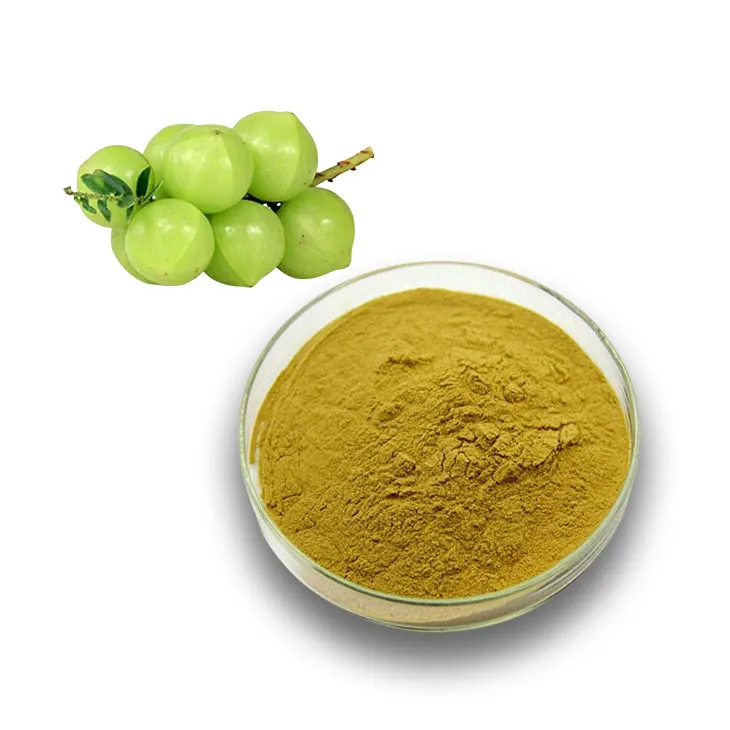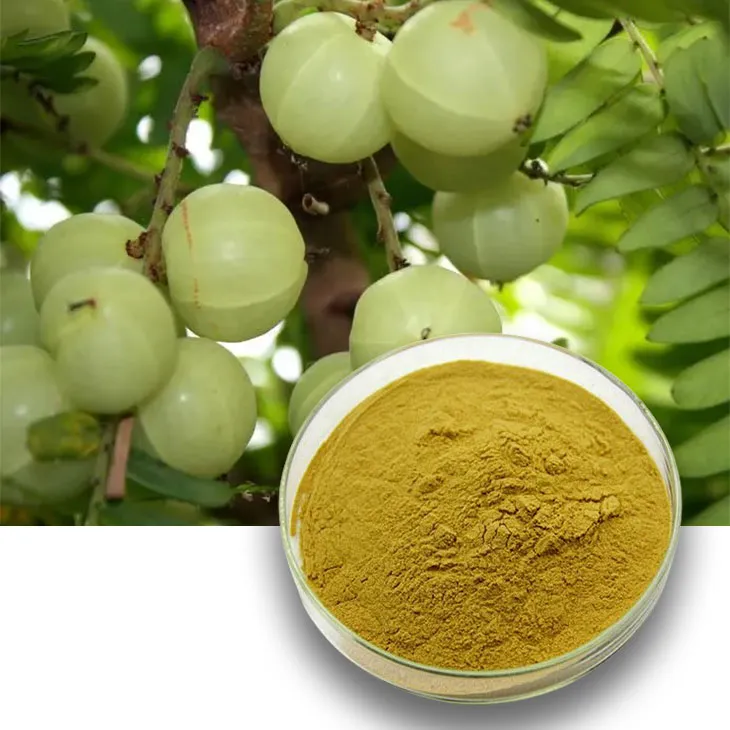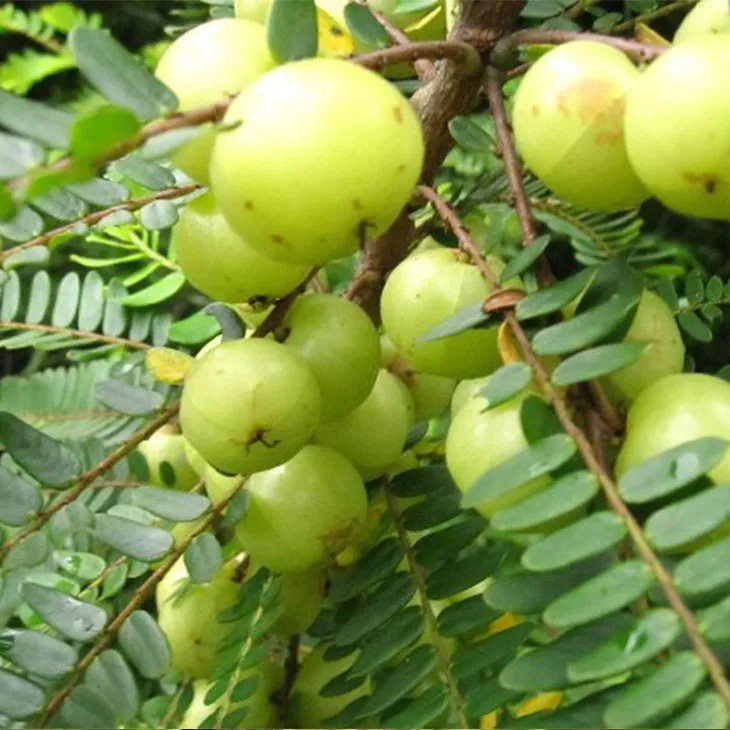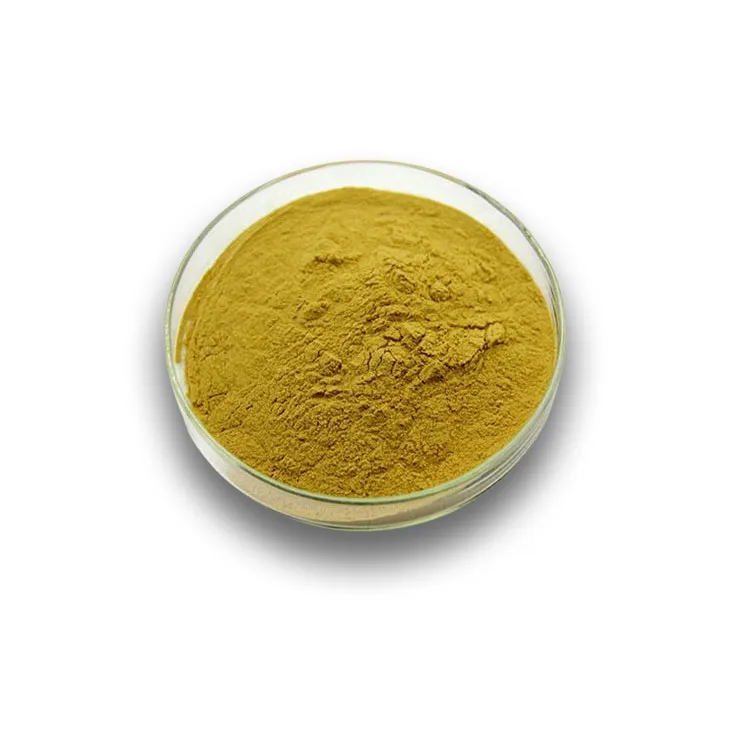- 0086-571-85302990
- sales@greenskybio.com
Active ingredients in Phyllanthus emblica extract.
2024-11-28

Introduction
Phyllanthus emblica, commonly known as Indian gooseberry or amla, is a plant that has been utilized in traditional medicine for centuries. Its extract is a rich source of various active components, each contributing to a wide range of potential health benefits. These components have attracted significant attention from both the pharmaceutical and nutraceutical industries, as they hold great promise for the development of new drugs and health - promoting products.

Terpenoids in Phyllanthus Emblica Extract
1. Types of Terpenoids
- One of the important terpenoids present in Phyllanthus Emblica Extract are oleanolic acid and ursolic acid. These are triterpenoids, which are a type of terpenoid with a complex structure.
- Mechanism of Action:
The terpenoids in Phyllanthus Emblica Extract play a crucial role in protecting the liver. They act as antioxidants, scavenging free radicals that are generated during various metabolic processes or due to exposure to toxins. For example, in the case of drugs or environmental toxins that can cause liver damage, oleanolic acid and ursolic acid can prevent the formation of reactive oxygen species (ROS) that would otherwise damage liver cells.
They also enhance the liver's natural defense mechanisms. By upregulating certain enzymes involved in detoxification processes, such as cytochrome P450 enzymes, they help the liver to more effectively metabolize and eliminate harmful substances. This dual action of antioxidant and enzyme - regulation makes them effective in protecting liver cells from damage caused by toxins and oxidative stress.
- Experimental Evidence:
Several in - vitro and in - vivo studies have demonstrated the hepatoprotective effects of these terpenoids. In cell culture studies, when liver cells are exposed to toxins along with oleanolic acid or ursolic acid, there is a significant reduction in cell death compared to cells exposed to toxins alone. Animal studies have also shown that supplementation with Phyllanthus emblica extract, rich in these terpenoids, can improve liver function markers in models of liver injury induced by chemicals or alcohol.

Polysaccharides in Phyllanthus emblica Extract
1. Hypoglycemic Effects
- Regulation of Blood Sugar:
Polysaccharides in Phyllanthus emblica extract have been found to have hypoglycemic effects. They play an important role in regulating blood sugar levels. One of the main mechanisms is through improving insulin sensitivity. Insulin is a hormone that is crucial for the uptake of glucose by cells. In individuals with insulin resistance, cells do not respond properly to insulin, leading to elevated blood sugar levels.
The polysaccharides in the extract can enhance the signaling pathways involved in insulin action, making cells more responsive to insulin. This results in better uptake of glucose from the bloodstream into cells, thereby reducing blood sugar levels.
- Metabolism of Glucose:
Another aspect of their hypoglycemic action is related to glucose metabolism. They can influence various enzymes involved in glucose metabolism. For example, they may enhance the activity of glycolytic enzymes, which are responsible for breaking down glucose to produce energy. By promoting the efficient metabolism of glucose, the polysaccharides help to maintain normal blood sugar levels.
Experimental studies have shown that when diabetic animal models are given Phyllanthus emblica extract containing polysaccharides, there is a significant reduction in fasting blood glucose levels over time compared to control groups. This indicates the potential of these polysaccharides in the management of diabetes.

Sterols in Phyllanthus emblica Extract
1. Cardiovascular Health Benefits
- Cholesterol - Lowering Effects:
Sterols present in Phyllanthus emblica extract are beneficial for cardiovascular health. One of the key ways they contribute to heart health is by helping to reduce cholesterol levels. Cholesterol, especially low - density lipoprotein (LDL) cholesterol, is a major risk factor for cardiovascular diseases.
The sterols in the extract can interfere with the absorption of dietary cholesterol in the intestine. They compete with cholesterol for absorption sites, thereby reducing the amount of cholesterol that enters the bloodstream. This mechanism is similar to that of some well - known cholesterol - lowering drugs, but with potentially fewer side effects.
- Other Cardiovascular Benefits:
In addition to cholesterol - lowering, sterols may also have other positive effects on the cardiovascular system. They may help in reducing inflammation in blood vessels. Inflammation in the vascular endothelium is associated with the development of atherosclerosis, a condition where plaque builds up in the arteries.
By reducing inflammation, sterols can potentially slow down the progression of atherosclerosis and reduce the risk of heart attacks and strokes. Although more research is needed to fully understand these additional effects, the initial findings suggest that sterols in Phyllanthus emblica extract could be an important component for cardiovascular health.

Synergistic Effects of Active Components
1. Interaction among Terpenoids, Polysaccharides and Sterols
- The multiple active components in Phyllanthus emblica extract, namely terpenoids, polysaccharides and sterols, do not act in isolation but rather interact synergistically. For example, the antioxidant effects of terpenoids may complement the blood sugar - regulating effects of polysaccharides. By reducing oxidative stress, terpenoids may help to prevent oxidative damage to pancreatic cells that produce insulin. This, in turn, can support the proper functioning of the polysaccharides in regulating blood sugar.
- The cholesterol - lowering effects of sterols can also be related to the hepatoprotective effects of terpenoids. A healthy liver is essential for proper lipid metabolism, including the synthesis and breakdown of cholesterol. Terpenoids that protect the liver can thus indirectly support the action of sterols in reducing cholesterol levels.
- This synergy among the active components results in a broader range of health benefits. For instance, the combined effects can contribute to better management of metabolic syndrome, which is characterized by a cluster of conditions including insulin resistance, high blood pressure, and abnormal lipid levels. The extract's ability to regulate blood sugar, reduce cholesterol, and protect the liver can help in preventing or alleviating the symptoms of metabolic syndrome.
- Furthermore, the overall antioxidant and anti - inflammatory properties of the combined active components can have a positive impact on general health. They can help in reducing the risk of chronic diseases such as diabetes, cardiovascular diseases, and certain types of cancers. This makes Phyllanthus emblica extract a promising candidate for further research and development in the fields of pharmaceuticals and nutraceuticals.
Conclusion
Phyllanthus emblica extract is rich in active components such as terpenoids, polysaccharides, and sterols. Each of these components has its own unique health - promoting properties, and when they work together synergistically, they offer a wide range of potential health benefits. The hepatoprotective effects of terpenoids, hypoglycemic effects of polysaccharides, and cardiovascular benefits of sterols, along with their combined actions, make Phyllanthus emblica extract an area of great interest for further research. Continued investigation into this plant extract could lead to the development of new drugs and nutraceutical products that can be used to improve human health.
FAQ:
What are the main active components in Phyllanthus emblica extract?
The main active components in Phyllanthus emblica extract are terpenoids (such as oleanolic acid and ursolic acid), polysaccharides, and sterols.
How do terpenoids in Phyllanthus emblica extract contribute to health?
Terpenoids in Phyllanthus emblica extract, like oleanolic acid and ursolic acid, have hepatoprotective effects. They protect liver cells from damage by toxins and oxidative stress.
What is the role of polysaccharides in Phyllanthus emblica extract?
Polysaccharides in Phyllanthus emblica extract have hypoglycemic effects. They can regulate blood sugar levels by enhancing insulin sensitivity and glucose metabolism.
Why are sterols in Phyllanthus emblica extract important?
Sterols in Phyllanthus emblica extract are important for cardiovascular health as they can help in reducing cholesterol levels.
How do the active components in Phyllanthus emblica extract work together?
The multiple active components in Phyllanthus emblica extract, including terpenoids, polysaccharides and sterols, interact synergistically to offer various health benefits.
Related literature
- Phyllanthus emblica: A Review of Its Phytochemistry, Ethnopharmacology, and Pharmacology"
- "Active Compounds and Pharmacological Activities of Phyllanthus emblica (Amla)"
- ▶ Hesperidin
- ▶ citrus bioflavonoids
- ▶ plant extract
- ▶ lycopene
- ▶ Diosmin
- ▶ Grape seed extract
- ▶ Sea buckthorn Juice Powder
- ▶ Beetroot powder
- ▶ Hops Extract
- ▶ Artichoke Extract
- ▶ Reishi mushroom extract
- ▶ Astaxanthin
- ▶ Green Tea Extract
- ▶ Curcumin Extract
- ▶ Horse Chestnut Extract
- ▶ Other Problems
- ▶ Boswellia Serrata Extract
- ▶ Resveratrol Extract
- ▶ Marigold Extract
- ▶ Grape Leaf Extract
- ▶ blog3
- ▶ blog4
-
Active components in dandelion leaf extract.
2024-11-28
-
Chinese Rose Hip Extract Factories.
2024-11-28
-
Supplier of Hedyotis diffusa extract.
2024-11-28
-
Diosmin
2024-11-28
-
Senna Leaf Extract
2024-11-28
-
Baicalin
2024-11-28
-
Hops Extract
2024-11-28
-
Fig Extract
2024-11-28
-
Quercetin
2024-11-28
-
Bayberry Extract
2024-11-28
-
Garcinia Cambogia Extract
2024-11-28
-
Medicinal Marshmallow Extract
2024-11-28
-
Red Vine Extract
2024-11-28





















